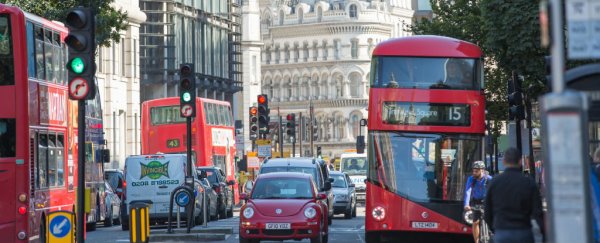At 7am on Friday, London officially breached the pollution limits set by the European Union for the entirety of 2016, making this the fifth year in a row that the city has significantly overshot the stipulated limits for toxic nitrogen-dioxide gas (NO2) pollution.
The fact that London used up its yearly pollution limit in a week isn't just bad news for the environment. Regularly inhaling NO2 pollution - much of which comes from diesel fuels - has been linked to respiratory and heart problems, and according to a report by King's College London for the local mayor's office, it contributed to 5,900 premature deaths in London in 2010.
"This is exactly why we are taking the Government back to court," said Alan Andrews, a lawyer for UK environmental law group, Client Earth. "Its failure to deal with illegal levels of air pollution, which causes thousands of early deaths in London every year, is a scandal."
Under EU law, various sites in London are given an hourly limit of 200 micrograms of NO2 per cubic metre of air, and they're only permitted to breach those limits 18 times in a year. But, as Adam Vaughan at The Guardian reports, Putney High Street in West London breached its hourly limit for the 19th time on Friday morning, with Chelsea and Kensington following close behind.
"Oxford Street has almost certainly also broken the limit already, having breached the hourly level a thousand times last year, but the monitoring station has malfunctioned," Vaughan writes.
Altogether, 291 square kilometres of London reached their annual limit for NO2 pollution in a week, which means some areas are now experiencing pollution levels similar to that of Beijing and Shanghai, according to a report published this week the UK-based organisation, Policy Exchange.
"It's just [that] central London, and London as a whole, ha[s] a really huge problem with NO2. Breaching so early in the year really just illustrates how big a problem it is," Andrew Grieve, an air quality analyst at King's College London, told The Guardian.
The news comes just months after London officials were ordered by the supreme court to publish an action plan on how they were going to address the NO2 pollution issue, which was prompted by ClientEarth. The plan was published in December, but several major cities in the UK including London, Leeds, Liverpool, and Edinburgh, are expected to continue breaching their annual limits for at least the next five years.
So what's going on here?
Ironically, it looks like some of the blame for the NO2 pollution levels is on measures that were been put in place with environmental protection in mind. Policy Exchange cites the massive increase in diesel-fuelled cars on UK roads as the main contributor to the current NO2 levels, reporting that they've increased from 7 percent in 1994 to a whopping 36 percent today.
"Included in a lower car-tax band, diesel vehicles have been favoured by the UK government due to their lower CO2 emissions and greater fuel efficiency," Feargus O'Sullivan reports for The Atlantic. "This favouritism unfortunately overlooked their considerably higher NO2 and PM emissions. Diesel cars have also lagged behind gas-run cars in emission improvements and, the report states, performed worse on the roads than they have in tests."
So while London has cut some of its emissions, including particulate-matter (PM) and sulphur dioxide pollution, they've yet to address the consistently dangerous NO2 levels.
According to The Atlantic, significant changes will be made in the coming years to properly address this issue (hopefully). In September 2020, certain high-congestion areas in London will start charging vehicles for access, which is expected to cut PM, NO2, and nitrogen dioxide pollution levels by 50 percent.
The city will also be addressing the bus emissions, with a spokesman for the mayor of London's office announcing this week:
"The mayor is leading the most ambitious and comprehensive package of measures in the world to improve London's air quality. His recent £10m bus retrofit programme has led to a sustained reduction in NO2 concentrations on Putney High Street."
Will it be enough? No way to know until it happens, and it'll be cold comfort for the locals who have already been subjected to illegal levels of toxic pollution for several years now.
